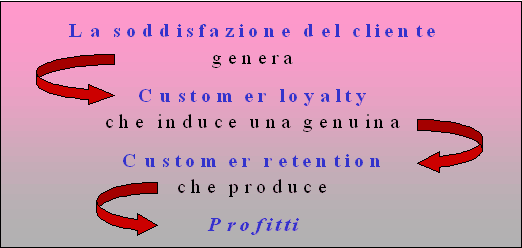Therefore like for the concept of "customer", also for that one of "satisfaction", or
"customer satisfaction" the definitions are multiple. One of these is: "the state in which the needs, desires, the expectations
of the customer are satisfied and carry to I buy back of the products and/or of the services it distributes to you and to the
fidelity to the erogatrice company".
Also in this case norm ISO 9000:2000 helps us, defining "Satisfaction of the customer: Perception of the customer on how much
its requirement have been satisfied " 3 .
Norm ISO evidences a fundamental aspect of the satisfaction concept, that is the perception of the customer.
This means that in truth the only criterion of appraisal that indeed you count is that one of the customer, and supplying a service, to seeming of the supplier, of quality, does not imply that the fruitore of the same one is satisfied.
In the perception of the customer satisfaction can be had, dissatisfaction or delight.
The satisfaction is the opinion of the customer who turns out from the refuse, positive negative or, between the perception of the prodotto/servizio acquired and its expectations.
Expectations and perception are influenced from the difference between the benefits (attended or perceived), supported costs (attended or perceived) and pointers of quality of the service.
The state of the satisfaction, defined in relation to the waits, can assume three states base:
- Satisfaction, when the expectations have been caught up.
- Dissatisfaction, when the expectations have been disregarded and they are found of the gap to overwhelm.
- Delight, when the expectations have been exceeded and indeed force points are found to maximize.
Two types of satisfaction exist: instantaneous and accumulated. The instantaneous satisfaction is that one perceived during the single purchase; that one accumulated is given from the sum of the experiences pregresse and forms in the customers a positive image of the just supplying one.
When the customer perceives a high level of accumulated satisfaction, she becomes stablily faithful, therefore loyal. The customer loyalty it is, in fact, definable like the intention or the predisposition of the customer to acquire a prodotto/servizio, provoked from the positive impression that the company has provoked in the previous relations.
Aware choice is one, a preference that the customer makes in the comparisons of supplying determining.
Various it is instead the case of the customer retention, that is of the customers withholdings, maintained.
Costoro is faithful in how much repeats the purchase from we, but they are not satisfied, of all or in part, of the servizio/prodotto received; they do not change supplier because of the high costs of change, or for lack of alternatives, like in the monopoly cases. In the case of customers withholdings because of barriers to mobility, therefore not in the case of monopolies, the fidelity condition can be forced until to a sure level, equivalent to the limit after which the costs of change sopportare in order to replace the supplier are greater of the value of the permanence as customer near the same one.
The value of the permanence is composed from two elements: the value of satisfaction (VS) that the customer perceives making use of the servizi/prodotti of the supplier puts into effect them, and from the structural costs of change (CCk) sopportare in order to change supplier.
The condition of stability of a customer with the supplier therefore is given from the expression: Figure 1,1 Condition of stability of a customer

Source: Gramma (1993) 4 It extension like a satisfied customer remains faithful to the same company until the satisfaction perceived from the received service, added to the structural costs of change, is greater of the change costs that it would be disposed sopportare also to change supplier (CCs).
The customer retention it can also be understanding in positive sense, that is like percentage of customers withholdings like consequence of one more and more strongly fidelizzazione.
The process that is created in this case is, in fact, following: Figure 1,2 the process of retention

Source: Fedel (1998) 5 This succession is guaranteed from a search carried out in the United States, concerning the relationship between level of satisfaction and rate practiced fidelity.
According to the same one, a variation of 10% in the index of satisfaction of the customer has like result one variation of the 9,5% in the rate retention.
- Note 3: Norm UNI EN ISO 9000, article 3,1,4, op. cit.
-
Note 4: Gramma, Customer Satisfaction, And ISEDI, Turin, 1993
-
Note 5: To Fedel, Thanks for the claim!, And FrancoAngeli, Milan, 1998


